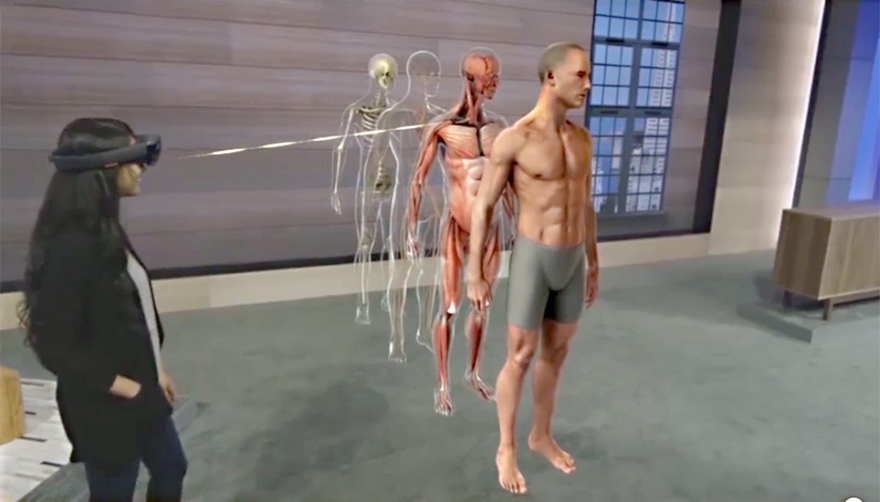Source: Cleveland Business
It may not be long before local surgeons start wearing funky, futuristic headsets while operating on patients.
Neurosurgeons at University Hospitals already are using a virtual reality headset called the Oculus Rift to prepare for real procedures. And now they’re seeking UH’s approval to use it during operations, with patient consent.
So if a surgeon was in the process of removing a brain tumor, he or she would be able to slide on the virtual reality headset and quickly tour a digital version of that patient’s brain.
Another futuristic headset could upend how medicine education is delivered at both Case Western Reserve University and the Cleveland Clinic: The two institutions, which plan to build a combined medical school campus at some point over the next few years, aim to create an anatomy curriculum that takes full advantage of Microsoft’s HoloLens. The device would allow medical students to study life-size holograms of the body and its organs — and manipulate them by waving their hands.
This is just the beginning, according to Dr. Warren Selman, chairman of the department of neurological surgery at UH Case Medical Center. He believes that the use of high-tech headsets in medicine is eventually going to become commonplace.
“After a while, you won’t think twice about it,” he said.
Today, neurosurgeons sometimes lose sleep the night before a big operation, as they try to visualize what they’ll see inside a patient’s brain. Using technologies like the Oculus Rift, however, they can walk around a tumor or an aneurysm and figure out exactly what they’ll need to do the following day, Selman said.
“This really changes your ability to visualize,” he said.
Beyond the screen
To create the system, a Mayfield Heights company called Surgical Theater spent a few months developing software that would allow its surgical simulation technology to work with the Oculus Rift.
For a few years now, UH and other major medical centers have been using Surgical Theater’s previous simulation systems to create 3D models of patients’ brains, using CT and MRI scans.
Until now, however, they could only study those models on a screen. If you want to really get to know your way around a brain tumor, for instance, it’s better to actually walk around it, according to Moty Avisar, president of Surgical Theater.
“It’s really something you can’t do with the screen,” he said.
Dr. Neil Martin agrees. He’s chairman of the UCLA Department of Neurosurgery, which is also using the Oculus Rift to enhance Surgical Theater’s software.
Using the technology is like “touring a house” — before long, your brain knows how to find the front door, the back door and the garage, Dr. Martin said in a news release about the technology.
Surgical Theater also might create a version of its software that works with Microsoft’s HoloLens — which eventually could allow surgeons to pull up holographic images without taking their eyes off of their patients.
“He can be Superman. He can see inside the brain while he’s working on the patient,” Avisar said.
The HoloLens has a lot of potential in medical education — and other fields of study, according to Mark Griswold of Case Western.
The radiology professor recently stood onstage at Microsoft’s Build conference to highlight that point. As he spoke, a woman portraying a medical student used her hands to manipulate holograms of different organs and organ systems.
For instance, while looking at the skeletal system, she waved her finger to focus on the femur and pull up images of some common fractures. Afterward, she showed off animated images of the cardiovascular system.
“This is a new way of seeing things,” he said from the stage.
Innovation wave
Case Western and the Clinic will be working with Microsoft to develop the digital anatomy content. But anatomy is just the beginning.
Griswold said the HoloLens could be used in all kinds of courses, as the woman on stage pulled up corresponding images (dinosaur bones for paleontology, a DNA strand for genetics, a sculpture for art, the Golden Gate Bridge for engineering).
“This could change how everyone learns,” he said.
Microsoft hasn’t set a release date for the HoloLens. Oculus VR, which is owned by Facebook, has said it will release the Rift to the masses during the first quarter of 2016. A few other companies, including Sony, plan to release their own headsets over the next year or so.
This isn’t the first time digital headsets have been used by doctors. For instance, two years ago, some surgeons, including one at Ohio State University, started using Google Glass to record surgeries and transmit them live to other doctors and medical students.
However, Google only released its Internet-connected glasses to a few thousand people as a pilot project. The company has yet to release it to the masses.
One of those doctors, Rafael Grossman of Eastern Maine Medical Center, believes that Google Glass and other wearable devices have “started a tide of change and innovation” in the health care industry, according to a post he made on his blog, RafaelGrossman.com, on Jan. 27.
“I see this trend as the beginning of a new way to do medicine,” he stated.

